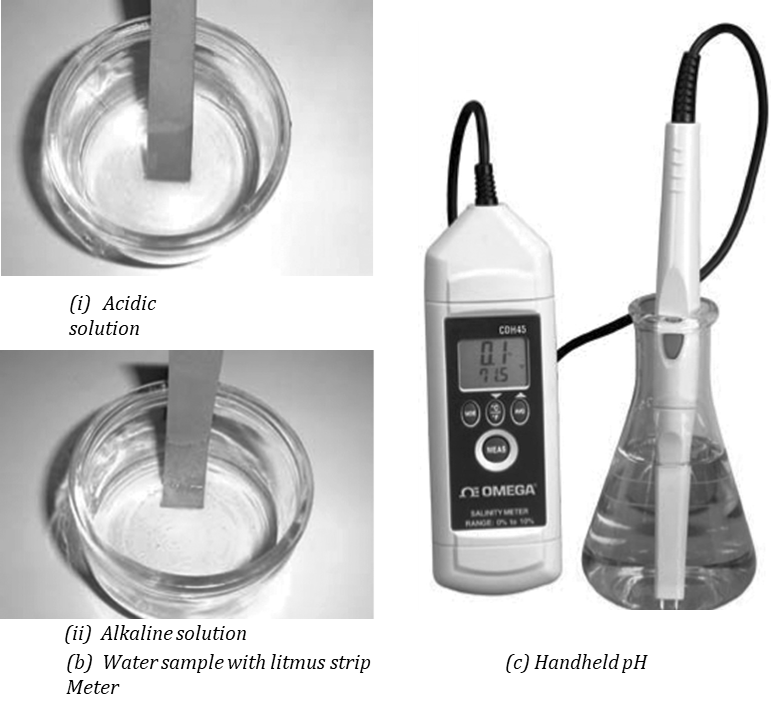Objective
To determine the pH value of the water sample for
use in concrete/mortar.
Theory
and Scope
Water plays an important
part in deciding the quality of the final product. The pH value of water is an indication
of its acidity/alkalinity, the property that directly affects the strength of
concrete, due to its chemical reaction
with the ingredients of cement.
The test determines the quality of water for use in concrete/mortars.
Apparatus
Litmus paper pack
Procedure
Step 1: Collect the water
sample representing water to be used for concreting or otherwise for any use
involving its mixing with the cement
during construction.
Step 2: Insert a litmus paper
strip into a water sample. Allow a reaction time of 10 to 20 seconds.
Step 3: Observe the change
in colour and match it with the reference coloured cover strip. The colour will
change according to the level of
concentration of acidic and alkaline substances in water.
Reference coloured cover strip colour
matching.
Observations
The pH value of the water sample is …………..; water is
suitable/unsuitable for the construction job.
Precautions
1. The sample of water taken for testing should be
representative of water proposed to be used for concreting, taking into
consideration the seasonal variation.
2. The sample shall not receive any treatment before
testing other than that envisaged in the regular supply of water proposed for use in concrete.
3. The sample shall be stored in a clean container
previously rinsed out with similar water.
Determination
of pH value of water sample
Discussion
The test results are
sufficiently accurate for determining the quality of water for use in
concrete/mortars. Ac- curate testing is
possible by the use of pH meter shown typically in Fig. 5.1(c) which is based on
potentiometric measurement of hydrogen
ion concentration in a sample.
pH meter It consists of a
glass probe which is placed in the water. Inside the thin glass bulb at the
end of the probe, there are two
electrodes that measure voltage. One electrode is contained in a liquid that
has a fixed acidity or pH value. The
other electrode responds to the H+ concentration of the water sample. The
pH electrode produces a voltage that is
proportional to the concentration of the H+ concentration, and making measurements with a pH meter is, therefore, a
form of potentiometry. A voltmeter in the probe measures the difference between the voltages of the two
electrodes and translates it into pH and displays it on the little screen on the meter.
Before taking a pH
measurement, the meter must be ‘calibrated’. The probe is immersed in a
solution that has a known and stable pH
(a ‘buffer solution’). The knobs on the box are used to adjust the displayed
pH value to the known pH of the
solution, thus calibrating the meter.
The water for construction
purposes should be of neutral nature, i.e., pH from 6.0 to 8. In case of high
pH of 10 to 12 or a low pH of 4 to 6, the
water will need suitable treatment for correction of pH value.
NATIONAL STANDARDS
IS 3025(Part 11) - 1983
(reaffirmed 2003): Methods of Sampling and Test (physical and
chemical) for Water and Wastewater; Part
11: pH Value
IS 3025 (Part 17) - 1984
(reaffirmed 2002): Methods of Sampling and Test (physical and
chemical) for Water and Waste Water;
Part 17: Non-filterable Residue (total suspended solids)
IS 3025 (Part 18)-1984
(reaffirmed 2002): Methods of Sampling and Test (physical and
chemical) for Water and Waste Water;
Part 18: Volatile and Fixed Residue (total, filterable and non-filterable)
IS 3025(Part 24) - 1986
(reaffirmed 2003): Methods of Sampling and Test (physical and
chemical) for Water and Wastewater; Part
24: Sulphates
IS 3025 (Part 32) - 1988
(reaffirmed 2003): Methods of Sampling and Test (Physical and
Chemical) for Water and Wastewater; Part
32: Chloride
REFERENCES
1 Gambhir, M. L., Concrete
Technology, 4th Edition, McGraw-Hill Education (India), 2009
2. Gambhir, M. L. and Neha
Jamwal, Building Materials: Products, Properties and Systems, McGraw-Hill Education (India), 2011.
FAQ
What is the pH value of
water is used for concrete?
The pH value of the water
should be between 6.5 and 8.5. The pH value of the water should not be less
than 6. If that type of water is used in concrete, it is corrosive because if the
pH value is 11 the cement will hold all the concrete ingredients.
How pH value in the
concrete is determined?
The in situ leaching method
for measuring pH in concrete is based on inserting a glass micro pH electrode
into a hole drilled in a concrete sample [4]. An Ag/AgCl electrode was used as
the reference electrode










The Better Co is a home construction company which helps you build your dream home and do your home interiors on one platform construction possible within your budget.
ReplyDeletehouse construction companies in hyderabad
"A water heater leak can lead to costly repairs and water damage." water heater replacement danville virginia
ReplyDeleteConsidering a heat pump water heater for my eco-friendly home. water heater replacement nm
ReplyDeleteSeal any gaps or leaks in your home to retain heat. water heater replacement berkeley california
ReplyDeleteWater heater blankets improve insulation and reduce heat loss. water heater replacement escondido
ReplyDelete